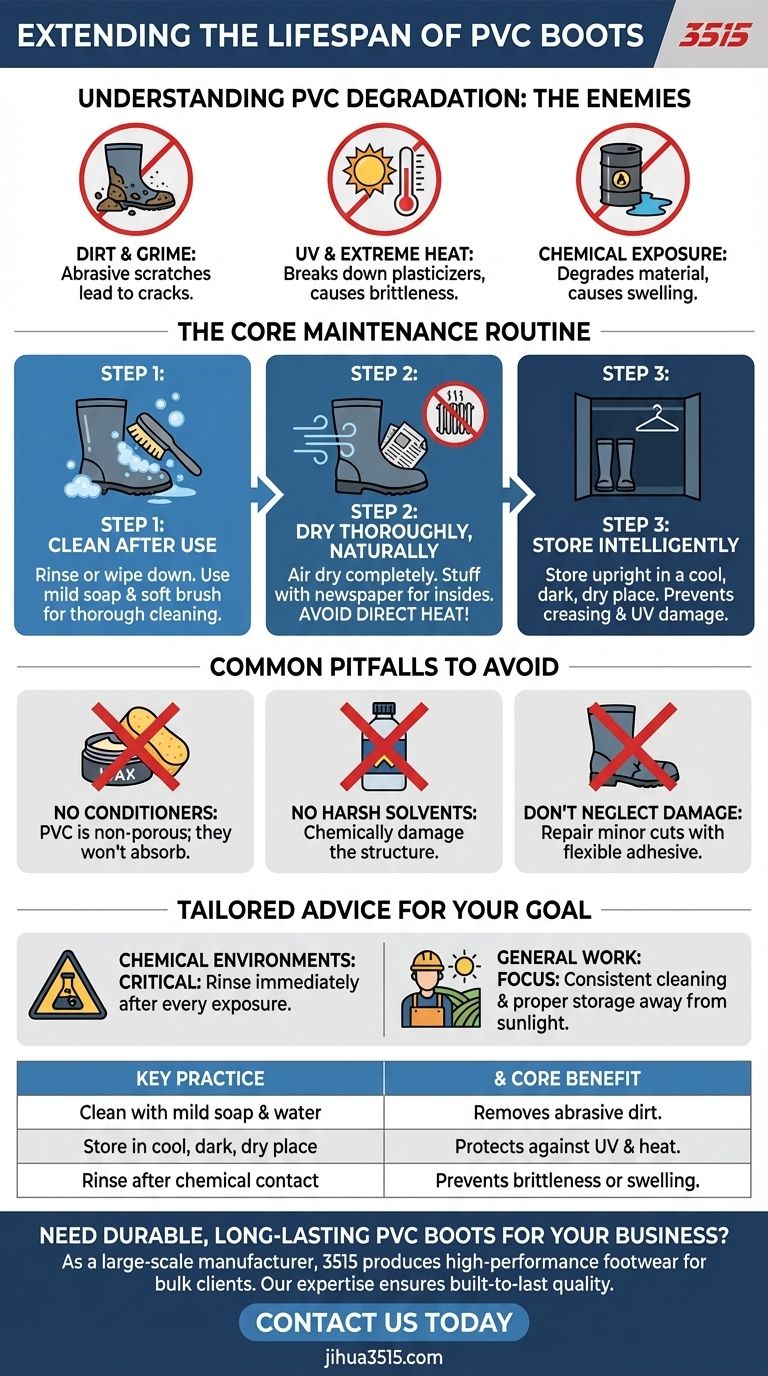To extend the lifespan of PVC boots, the most effective strategy combines three core practices: cleaning them regularly with mild soap and water, storing them in a cool, dark, and dry place away from direct sunlight, and rinsing them immediately after any contact with harsh chemicals. These simple habits directly counter the primary factors that cause PVC to degrade, such as physical abrasion and material brittleness.
While PVC is a resilient and waterproof material, it is not indestructible. Its longevity depends less on complex conditioning and more on preventing the physical and chemical stresses that cause the plastic to become stiff, brittle, and prone to cracking over time.

Understanding PVC Degradation
To properly care for PVC boots, it helps to understand what you're fighting against. Unlike leather, which dries out, PVC is a stable plastic polymer. Its primary enemies are physical stress, extreme temperatures, and chemical exposure.
The Impact of Dirt and Grime
Abrasive materials like dirt, sand, and gravel can cause microscopic scratches on the boot's surface. Over time, these small imperfections can deepen and develop into weak points that may eventually crack.
Regular cleaning removes these abrasive particles, preserving the integrity of the PVC surface.
The Threat of Temperature and UV Light
Extreme temperatures are a significant threat. High heat and direct sunlight (UV radiation) can cause the plasticizers in PVC to break down. This chemical process makes the material lose its flexibility, becoming stiff and brittle.
Conversely, extreme cold can also make PVC less flexible and more susceptible to cracking when flexed.
The Danger of Chemical Exposure
Many chemicals, including certain oils, fuels, and industrial solvents, can react with PVC. This exposure can degrade the material, causing it to soften, swell, or become brittle much faster than it would naturally.
This is why immediate rinsing after contact with unknown substances is a critical step for longevity.
The Core Maintenance Routine
A consistent care routine is simple yet highly effective. It requires only a few minutes after use but can add months or even years to the life of your boots.
Step 1: Clean After Use
After each use, rinse or wipe your boots down with a damp cloth to remove loose dirt and mud. For a more thorough cleaning, use a soft brush with mild soap and water.
Step 2: Dry Thoroughly, but Naturally
Ensure both the inside and outside of the boots are completely dry before storing them. If the inside is wet, stuff the boots with newspaper to absorb moisture.
Crucially, avoid direct heat sources like radiators or campfires, as intense heat will damage the PVC.
Step 3: Store Intelligently
Store your boots upright in a cool, dark, and dry location, such as a closet or garage. This prevents creasing, which can create weak spots, and protects the material from UV and heat degradation.
Common Pitfalls to Avoid
Correctly caring for PVC often means knowing what not to do. Many practices that are beneficial for other materials can be useless or even harmful to PVC.
Misconception: Conditioning PVC Boots
PVC is a non-porous plastic. Leather conditioners, waxes, or rubber treatments will not be absorbed. At best, they will leave a greasy film that attracts more dirt; at worst, they could react negatively with the material.
Mistake: Using Harsh Solvents for Cleaning
Never use harsh cleaning agents, solvents, or petroleum-based products to clean your boots unless they are specifically designed for PVC. These can chemically damage the material, compromising its structure.
Mistake: Neglecting Minor Damage
Small nicks or cuts can allow water to seep in and can easily grow into larger, unrepairable cracks. Inspect your boots periodically and repair minor damage with a waterproof, flexible adhesive designed for plastics to prevent problems from escalating.
Making the Right Choice for Your Goal
Your specific use case should guide your maintenance priorities.
- If your primary focus is use in chemically hazardous environments: Your most critical habit is rinsing the boots thoroughly with water immediately after every single shift or exposure.
- If your primary focus is general farm, construction, or garden work: Consistent cleaning to remove abrasive grit and proper storage away from sunlight are the most important factors for long-term durability.
Ultimately, protecting your investment in PVC boots comes down to a few simple, consistent habits that preserve the material's inherent strength and flexibility.
Summary Table:
| Key Practice | Core Benefit |
|---|---|
| Clean with mild soap & water | Removes abrasive dirt to prevent surface damage. |
| Store in a cool, dark, dry place | Protects against UV light and heat degradation. |
| Rinse after chemical contact | Prevents material from becoming brittle or swelling. |
Need durable, long-lasting PVC boots for your business? As a large-scale manufacturer, 3515 produces a comprehensive range of high-performance footwear for distributors, brand owners, and bulk clients. Our expertise ensures your boots are built to last from the start. Contact us today to discuss your specific needs and benefit from our extensive production capabilities for all types of shoes and boots.
Visual Guide

Related Products
- Premium High-Cut Waterproof Safety Boots Manufacturing & Wholesale Solutions
- Wholesale Waterproof Tactical Boots Custom Suede & High-Traction Soles
- High Performance Fire-Retardant Waterproof Safety Boots
- Heavy-Duty Waterproof Nubuck Safety Boots Safety Shoes for Bulk Supply
- Factory Direct Wholesale Rain Boots Durable Waterproof & Fully Customizable
People Also Ask
- What are the different types of safety toe boots available? Choose the Right Protection for Your Job
- What is the general recommendation for both steel and composite safety footwear after a significant impact? Replace Immediately for Safety.
- What organization provides safety standards for work boots? Meet ASTM International, the Key to OSHA Compliance
- What is the compression resistance requirement in ASTM standards? Essential Guide to the 2,500-lb C Rating
- What are the characteristics of steel toe boots? Maximum Protection & Key Trade-offs



















